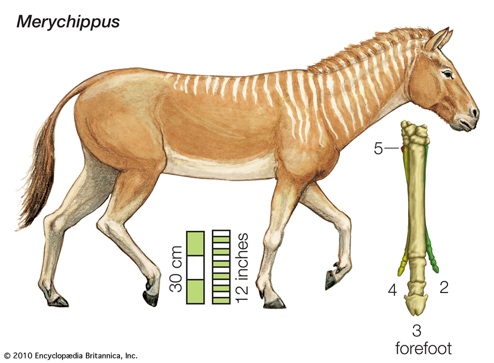
General Information
Much later than Mesohippus lived the horse species Merychippus, which inhabited the territory of modern North America about 17 million years ago. Despite the teeth modification, the diet of Merychippus is still herbaceous. Remarkably, Merychippus was the species of ancient horses that gave rise to parallel subspecies: apparently due to the wide distribution of Merychippus across North America. Merychippus retained high speed, and the presence of hooves allowed them to move not only on dry grassy terrain. It is often thought that Merychippus had a distinctive striped coloration reminiscent of a zebra or tiger, which is apparently a device for additional protection in the steppe plains of North America against dangerous predators.
Skull structure
The skull of Merychippus was considerably improved and was an oblong shape, typical of modern horses. The brain cavity of the skull was also enlarged by expanding the brain, making these animals probably more intelligent than ancestral forms. The rounded, deep eyeball openings were retained, but their location shifted slightly so that Merychippus could see much more. During the lifetime of Merychippus, there were significant climatic changes, resulting in the transformation of vast forested areas into fields and steppes, which provoked changes in the dental tissues of the animals. The dental apparatus also undergoes changes: the teeth receive cementum tissue. At the same time, the teeth have a distinct ridge shape that allows an increase in the area of chewing grass.
Structure of the postcranial skeleton
The size of this species did not exceed one meter, which resembles a modern pony. At the end of each limb, keratinous growths appear, which gradually form the modern hoof. The spine of the Merychippus also undergoes changes as the cervical section becomes slightly longer due to the increased size of the cervical vertebrae. Increased development of the ulnae and radial bones is observed, as well as a movement toward the lateral toes to form actual hooves. Now, the total load was not on the longest toe but mostly on the inner toes, while the outer toes had almost no functional role.